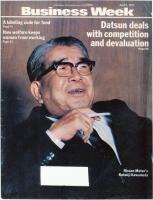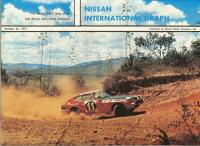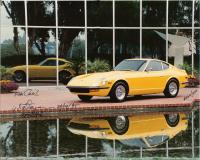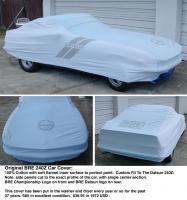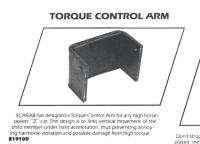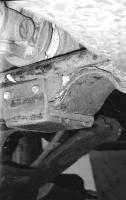Everything posted by Carl Beck
-
Business Week, April 7, 1973, interview with Katsuji Kawamata, president of Nissan Mo
Hello GrandPrixGreen: If you haven't already done so - I would highly recommend that you buy a copy of "THE RECKONING" by David Halberstam, a Pulitzer Prize winning journalist. Mr. Halberstam walks you though both Ford Motor Company and Nissan Motor Co. Ltd post WW-II; and gives you an insight into the people who ran the companies, their strategies and inside corporate politics. The book is out of print now - but you can order a used copy from Amazon.com http://www.amazon.com/Reckoning-David-Halberstam/dp/B000LBFPTE/ref=sr_1_1?ie=UTF8&s=books&qid=1256053481&sr=1-1 From Halberstam's "THE RECKONING" Writing about how Kawamata came to be assigned to Nissan in 1947 and a little about the character of the man: "The Banker was a 42 year old man named Katsuji Kawamata, and he knew nothing about cars, not even, it was said, how to drive one. He knew even less about production and manufacturing. But he knew about money; he was a man of the bank." and "Kawamata, the banker from IBJ {Industrial Bank of Japan} was an immensely ambitious man, but few of his contemporaries at the IBJ had perceived the full measure of that ambition. On the surface he had not seemed that driven. By the standards of Tokyo's bankers, some of whom were exceedingly sophisticated and polished, men who either were from the upper class or were imitating it, he was a bit primitive - almost, it sometimes seemed, deliberately so. He had appeared a little too rough, too blunt, for a successful career at the bank and in 1947 he had been shunted off to Nissan, so urgently in need of financial help. The news of his transfer had not pleased Kawamata either. He was somewhat angered by the rebuff implicit in his being moved around. Indeed there were old colleagues of Kawamata's who thought that he had been somewhat lazy at the IBJ, and that it was only when the bank scorned him and placed him outside that he became ambitious, af if to prove that the IBJ had been wrong. Immediately after the war, fresh out of the army, Kawamata had returned to the bank as assistant manager in the loans department in Tokyo. He was resentful and irascible, his attention rarely focused. Like so many Japanese at the time, he was overwhelmed by a personal defeat as well. The Japan he had been a part of had failed completely; lost in that collapse were all his hopes. He was not sure how much point there was to postwar life. ("Not just the cities but the hearts of the people have been burned out"; Edwin Reischauer wrote of that period). At the office he tried all day to edge nearer a small electric stove, with an old army overcoat over his head as a kind of cape to keep him warm. Some superiors urged him to work harder, but he did as little as he could." = = = = = = = = = = = = = = = = = = = = = = = David Halberstam writes of Katayama: "Katayama's privileged childhood had made him different than other Japanese. For one thing it had given him a desire for a higher level of independence. For another it had made him an absolute car nut. He had grown up with classic cars in his family. His Father had owned two very sporty cars, an Erskine and a Star Durant. In the post war years when everyone else was preoccupied with finding a place to live and something to eat, Katayama was obsessed with finding a vintage car to drive and a place where the roads were not so bad that they would destroy it. He organized the first post war auto sports club in Japan. Its members were Japanese with found memories of other days and a handful of American Officers; their cars were a few treasured MG's and some prewar roadsters lovingly reconstructed. It was his love of cars that had brought him to Nissan. His fellow workers saw Nissan as a big company likely to expand. Katayama chose Nissan because it was about cars, and he was about cars, and he not only wanted to build them, he wanted to drive them. At one point in the early 50's, frustrated with the politics of Nissan, he tried to start his own company. He and a friend tried to design their own car, an ultralight car for people in a poor country where gas was expensive. The Flying Feather, Katayama named it. They built a prototype in the second story of a Tokyo office building, then found they could not get the car out the door. Finally it was taken out though the window. He was, he decided an insufficiently practical man to run his own company. That did not diminish his love of cars. When he was not working at Nissan, he was out driving a car as fast as he could. In a nation filled with laws and restrictions and inhibitions, racing around in a sports car was to him the highest form of personal expression. Years later when he became the Head of Nissan on the the American West Coast and purchased a house at Palos Verdes, California, he continued to speed. It was said of Katayama that he had more speeding tickets than anyone else in town. At first he passed himself off to the local traffic cops as a simple Japanese Businessman who knew no English, but the cops soon caught on. One of them would chase after him, catch up with his car, and say, "Good morning how are you today, Mr. Katayama. And by the way here is your ticket. By the end of his tour he had a chauffeur, since if he had gotten another ticket he would have lost his license." - - - end quotes - - - - I believe it would be very hard for anyone outside of America, that did not have a "Katayama" in charge of Nissan's Operations in their countries - to fully comprehend just how good his Leadership and Management Skills were, nor just how great it was to be a Datsun Dealer, Datsun Customer or Datsun Enthusiast during his stewardship of Nissan Motors USA. With Katayama at the head of the organization, Datsun along with its Dealers, Customers and Enthusiasts went from being the underdog in the market, to being Top Dog, both in sales and on the competition tracks of America. That success was worked for, and fully shared by, everyone involved. I guess that is the basis for the Datsun Heritage in America. I suppose that is to a very great extent, is also why so many of us resented the fact that Nissan Motor Co. Ltd was so set on its destruction. FWIW, Carl B.
-
Business Week, April 7, 1973, interview with Katsuji Kawamata, president of Nissan Mo
Hello GrandPrixGreen: Mr. Kawamata and I had at least one thing in common in 1973 - we both smoked "Kent Cigarettes". I believe that Mr. Kawamata's remarks were honestly made. I think that when he was looking back though the eyes of a Banker, all he could see was the additional expense of supporting the advertising expense of maintaining two Brand Identities. On top of that however is Kawamata's reportedly huge ego. He was reportedly upset that people in the US didn't treat him like the President of GM, FORD or Chrysler, nor recognize his importance to the same extent as the President of Toyota. After all that effort to bring everything under a single Brand Name - - one has to wonder why Nissan would launch the "Infiniti Brand" to stand alone from the Nissan Brand. Or we have to wonder when they will change that Brand Name back to Nissan?
-
Old Nissan U.S.A.Newsletters
Hello GrandPrixGreen: We received "NISSAN INTERNATIONAL GRAPH" in 1971 when I sold Datsun's for a local Datsun Dealer. Later I was a New and Used Car Sales Manager for another Dealership owned by the same family; I received several different publications from Nissan Motors Ltd. in Japan. I only kept a few issues that related to the DATSUN 240Z {which was my main interest at the time} I recall having copies of "Nissan Compass" - but can't find them right now. All these publications were available in our Customer Waiting Area for the Service Department. Later the name and format of the publication was changed to "Nissan-Datsun Rally and Race Digest" Both came from "NISSAN MOTOR CO. LTD, International Advertising (E05), Export Division, `7-1, Ginza 6-Chome, Chuo-Ku, Tokyo 104, Japan. FWIW, Carl B.
-
S30 Unilite MSD info - P/N's and Prices
What did you set the advance in the Unilite too? What does the spark advance curve look like? thanks, Carl B.
-
Everyday drivability of Triple carbs
Hi Andy: I have ran triple Weber 40 DCOE's on my 72 since 1975. Once they were properly set up - I never had an issue with them again. You can hook up the chokes on the DCOE's, although I never actually needed them here in Florida. I'm pretty sure I have 36's for actual choke size inside the 40 DCOE's on my L28. Want to enjoy driving your 240Z? Run the S.U.'s with electronic ignition. Want a "wow" factor under the hood - triple carb's man. Want to have a car that will start and run very well all the time - - get a modern Fuel Injection system. In all three cases, the induction system has to be set up and tuned/programmed to perfection. A few dyno runs with someone that knows what they are doing is worth every penny. Personally - today - I'd opt for a modern fuel injection system. If you want looks and performance perhaps fuel injection via the triple throttle bodies... Just my opinion... FWIW, Carl B.
-
Mr. K's Selection 240Z
Hi Sara: If you are serious about this - I would suggest that the first step would be to find and buy a set of the G-Nose headlight covers. If you look at the picture I Posted, you can see that they are shown in the assembly of the factory parts. The last set of G-Nose headlight covers that I saw on E-Bay were NOS, sold over a year ago, and they went for around $1,200.00 If you take your time you might find a good used set for $600.00 to $800.00. The Web Site you listed - also show the hood hinges which are needed. So you might want to start shopping around for a set of them as well. Again a used set may save you some money. You'll need both the headlight covers and the hood hinges no matter which supplier you buy the fiberglass part or parts from. Nonetheless you'll want to check with whatever body shop you plan to have perform the work. Some body shops have the skills/ability/experience to work with less expensive parts {rough molded} and others will want to use only the highest quality "bolt on" parts. So beware of what would appear to be cheap/inexpensive parts, as their use may cost you two to three times as much in body shop labor, than it would have cost to install higher quality parts that are bolt-on and near ready to finish. FWIW, Carl B.
-
My cash for clunkers program
Hi Rick: We are pretty sure that the external colors and interior colors listed here are correct. http://ZHome.com/History/colors.html Note that interiors called "white" in 72, became "Beige" in 73. An off white that was Flame Retardant per FMVSS for the 73 model year and forward. Although if they are not sitting side by side, they both look white to most people. Also note that there were some different mixes for Canada
-
Mr. K's Selection 240Z
Hello FastWoman: The Z - is the 1972 Datsun 240Z that was owned and driven by Mr. Katayama while serving as President Of Nissan Motors USA. It has a "G-Nose", custom mix Yellow Pearl Paint with firemist metal flakes, wire wheels and Automatic Transmission. When Mr. K. retired before returning to Japan, he gave the car to his long time Administrative Assistant, Johnnie Gable and her son Kenny Ueda. Kenny owns it to this day and Nissan Mortors still uses it for advertising/promotion. It was most prominently featured in Nissan's $500,000,000.00 Datsun Heritage advertising/promotion campaign in the late 90's as Nissan struggled to tie its past glory with Datsun to its then bleak present. The Super Bowl Ad - "the Dream Garage" lead a series of T.V. Ad.'s featuring a representation of Mr. K {played by an Actor} in the Ad.'s. I believe that there are still sources for the "G-Nose" if you would like to add one to a 240Z. It was offered on the Fairlady 240ZG in Japan, but was not an export model. Pictured below: Photographic copy #260 of 300 - represents my IZCC Membership number - 260 Photo of the "G Nose" FWIW, Carl B.
-
Datsun Heritage
Hello GrandPrixGreen: To put the full concept of the Datsun Heritage Museum into concise terms is not really possible here, but if you are interested in gaining some understanding of the intent - I'll give it a try. Nissan Motors Ltd. Japan, established their own sales and distribution organization here in America. To protect themselves under U.S. Law, they established Nissan Motors in USA Inc. A wholly owned subsidiary of Nissan Motors Ltd in Japan. {there is no public ownership of Nissan Motors USA}. First - clearly understand that there is a huge difference between a "Datsun Museum" and a "Datsun Heritage Museum". A "Datsun Museum" would have a primary focus on Datsun Vehicles, it would be all about the cars and trucks. An attempt to capture their history via snap shots in time. On the other hand - the "Datsun Heritage Museum" is all about the people involved with the Datsun Brand of cars here in America. It is about the people that built something of significance, something of value and who then passed that on to following generations. Things of value go beyond money, they include personal values of individual effort, integrity, pride, cooperation with others, connection with and contribution to one's community. etc etc etc. Human values flow from generation to generation and within organizations they originate and flow from the top down. Your heritage is comprised of things of value passed from one generation to the next. The Datsun Heritage Museum here in the U.S.A., was founded by private investors with no help/funding from Nissan. Their intention is to capturing the story of how the Datsun Brand of Japanese automobiles were brought to America, how people had to strived to overcame many cultural, financial and business obstacles during their startup years - while laying the foundation for future growth and future success. Growth and success not only of the Datsun Franchise, but of the people involved. We hope that "story" will be captured in hundreds of individual examples. People that worked for Nissan Motors USA, people that became Datsun Dealers, people that bought Datsun's and received something more than just a car. People that raced Datsuns. people that repaired them, people that drove them. "The Heritage" that has been passed on now to two and in some cases three generations of American's, is a heritage rich in the values of individual hard work, risk taking entrepreneurship, personal growth and development. The Datsun Heritage in the USA, is rich with stories of economic upward mobility provided by free and open markets, where competition from all corners of the earth can be matched or beaten. The Datsun Heritage here in America is one of individuals recognizing "Opportunity Knocking", grabbing it and fully developing it. The Datsun Heritiage here in the USA is one of a major corporation willing to reach down to enthusiastic individuals of limited means, then working together with them for mutual benefit. {a business model that the major US Auto Makers had long before forgotten}. Nissan U.S.A grew from very humble beginnings along with its first 10, 100, 500 and 1000 Datsun Dealers. Many of the people that helped found the distribution chain of Datsun Dealerships in the early 60's, started with very little to no personal wealth, no experience in Dealership Management etc. etc - and twenty years later retired as multimillionaires. Still others continued their growth and development to this day. One of our Board Members is Mike Sage for example. His Father was one of the first Datsun Dealers on the West Coast. Today Mr. Sage owns the Sage Auto Group, which in turn now owns/operates Infiniti, Mercedes-Benz, Scion, Toyota and Nissan Dealerships. Mike Sage understands the value of the heritage passed on to him from that original Datsun Dealership. I bought my first Datsun from Paul Jaremko in Spokane, Washington. Paul's parents were one of the first 50 Datsun Dealers in the US. Prior to gaining a Datsun Franchise, they owned operated a used car lot. Now some 40 years later, Paul is passing on that heritage to his son's via Jaremko Nissan Saab. Paul by the way won Datsun their first SCCA Regional Championship in 1963 driving a Datsun 1500 roadster, he and his son still race Datsun roadsters in the Pacific Northwest, and his son has won several SCCA championship titles. This family is rich in Datsun heritage . Within the physical museum, there are and will be many Datsun vehicles and many items of Datsun memorabilia. In and of themselves they are an interesting and fun bit of history - - but in a more abstract sense they are all icon's that remind us of the heritage of unlimited opportunity we Americans have inherited. Unlimited opportunity based on the values of individual effort and self-reliance in a land that provides individual freedom and liberty, combined with a capitalistic system operating in free and open markets. A heritage that Nissan shared in by coming to America with their Datsun Brand. {opportunity denied to them at the time in many closed or restricted markets around the world}. Yes, we hope people will come to the museum to see the cars and things - but we really hope they will leave with a deeper understanding of the things of lasting value, passed on from generation to generation long after the Datsun Brand disappeared in America. This Classic Z Car Club is itself a part of the Datsun Heritage. While the Z Car brings us together with a common interest, we hope that there is something of equal or more value here. Hope that gives you a little better understanding of the purpose of the Datsun "Heritage" Museum here in America. FWIW, Carl B.
-
'Datsun Heritage Museum' interview clip
Moved...
-
Datsun Heritage
Very Interesting. I want to make sure I understand the distribution and sales organization in Norway. 1.Nissan built the cars in Japan, then sold them to Marubeni who transported them to Norway and then distributed them to their {Marubeni's} local Datsun Dealers. Would that be correct? 2.Later Marubeni collected and restored the cars - and then sometime later sold them off to the public. Would that be correct? 3. Do you know how many Datsun Dealerships were in Norway between 1960 and 1980? thanks, Carl B.
-
Looking for a lost love, please read.
Hi Rick: Here is one for you - I found a buddy's 240Z after several years of looking... http://www.classiczcars.com/forums/showthread.php?t=31481&highlight=Bill+Jones FWIW, Carl B.
-
00030 sighted today
Thanks Bruce. MEZZ: By all means let us know what you find - you never know till you go look. FWIW, Carl B.
-
00030 sighted today
Hi Bruce: So - - in effect you are telling us that Steve bought and now owns the #30 car - Yes/NO ? Or are you telling us that Steve is servicing the car and storing it for David? thanks for the update... Carl B.
-
Best car cover for an early Z?
Hi richard1: Can you post a picture of the NOAH on your Z? Is it as much a "custom" fit as the original BRE Covers? thanks, Carl B.
-
Opinion on this diff. mount from Ebay
To much vibration and noise transmitted into the cabin for a street car. Not a good solution. The rear end already makes too much noise...
-
Targa Newfoundland 2009
Hi TimG: Thanks for posting the links - great vid's. Your Z looked great, sorry you had a problem. Nonetheless it had to be a ball .... Hats Off to you... FWIW, Carl B.
-
Difference between '70/'71 and '72 Cylinder Head
As far as I know - it was used only on the 73 Model Year vehicles. I don't believe it would have been legal to use it on the 72's without certifying it with the EPA for 72... and that would have been a time consuming and expensive process, that Nissan would have wanted to avoid. BTW - that chart that Jim Wolf put together lists the 73 E88 as N33 and the 74 E88 as N33/P50. The 72, 73 and 74 heads all have E88 cast into them externally - I think Jim used N33 and P50 as references to the Nissan Part Number for them - so that they would not be confused with the casting numbers.. FWIW, Carl B.
-
Oregon or Bust!
Hi Frankie: I am enjoying your reports from your Road Trip - but sorry to hear that you lost a Tranny. It can be a real bummer to be stick out on the road so to speak and expensive to resolve as well. We'll all hope that the transmission you have coming is a good one this time. It might be helpful if you specified exactly what town you are in. The bottom of MN is a pretty large area.... FYI - in general terms... Transmission Fluid is a usual name for Automatic Transmission Fluid. It is actually a very high detergent 10 weight oil. "Tranny Fluid" lubricates the moving parts in an A/T but its main function is to provide hydraulic pressure upon which the A/T operates. A/T's use a transmission cooler usually built into the radiator of the car to dissipate the heat. Years ago, in the 40's - DeSoto had what they called a "Fluid Drive" transmission - so who knows - maybe that is where the "fluid" term for A/T's got started. Gear Lube or Gear Oil is the usual term for the very thick lubricating oil used in standard transmissions and differentials. It is usually 75 to 95 weight and contains additives to prevent foaming when it's stirred by the gears rotating though it. Its main function is to lubricate the gears and bearings - and secondarily it carries heat generated at the gears to the transmission case - where it can be dissipated externally. Keep us Posted on your progress - we'll all be pulling for you. FWIW, Carl B.
-
Cost to Install A/C
From memory - The Vintage Air Evaporator Kit was something close to $495.00. That gives you the evaporator that includes a heater core, A.C. Controls and wiring, outlet vents and piping etc. The Vintage Air UniFlow Condenser {for R134a}, and Dryer was around $225.00 A rebuilt Hitachi Compressor from the 280ZX was expensive at $325.00, but I could use the compressor mount from the 280Z and the belt tensioners etc. Custom Built hoses were around $270.00 total Installed it myself so labor was free. $1315.00... plus a few other small items. I did this a few years ago so price will be somewhat different today... I would not recommend using the Hitachi compressor - it was too expensive compared to other offerings - so you might save a couple hundred in that area. Not really a perfect option if you want to maintain a pure stock look - but the Vintage Air unit will cool a 240Z here in Florida - something that the old style add on units that suck though the evaporator and then blow though the stock heater/vents would never do. With the new Vintage Air totally electronic controls - it would be possible to maintain a pretty stock look, but it would take a bit of extra work... FWIW, Carl B.
-
Cost to Install A/C
Hi Dennis: Prices change to reflect the ever lower "value" of the Dollar. Interesting that adjusted for inflation - using the questionable CPI - What cost $325.00 in 1972 would cost $1654.79 in 2008. Pretty close - yes? FWIW, Carl B.
-
Difference between '70/'71 and '72 Cylinder Head
First - are you certain that the "72" cylinder head is a "72"? The reason I ask is because cylinder heads from 73 and the 74 260Z's were also cast with the E88 casting numbers, but their combustion chamber design is quite different. The 73/74 heads are designed to meet the stricter emissions standards of those years... not for the best performance. You can see the difference here: http://ZHome.com/ZCMnL/tech/E31andE88Heads.htm The combustion chamber design is the same on the 70/71 E31 and 72 E88. The E88 combustion chamber has a 2.3cc larger volume. {42.4cc vs 44.7cc}. The E88 has slightly redesigned intake and exhaust ports. The radius of the curves in the ports was changed to improve the heads breathing. So with slightly lower compression but better flow though the ports the E88 produces the same HP as the E31 when mounted on an otherwise stock L24. The exhaust valve seat casting was changed slightly in the E88 as well. The E31's suffered from cracking around the exhaust valve seats. If you plan to use the E31 be sure to have it checked for fine line cracks in that area. Any good head shop can weld them up if they are otherwise good, but it isn't cheap. Since you have both - I'd have a good head speciality shop inspect them both - then use the one that is in the best condition. Consider the condition of the valve train at the same time.. New rockers and cam's aren't inexpensive. good luck with the rebuild... FWIW, Carl B.
-
Insulator Mount Installation
Another alternative is the fairly simple solution used on the SCARAB's... Simply bend a 3/8's steel plate to wrap around the bottom of the cross member and put some rubber between it and the cross-member. Then bolt it to the stock mount. Search for Paul Richer Differential Mount on HybridZ.org. Simple to make and cheap too. FWIW, Carl B.
-
70 240Z For Sale on Ebay??
Mike: #22 is indeed 10/69 #27 and #36 corrected on the Register - thanks. Rick: We may never know exactly how cars came out of the factory - nor when the data plates were applied. We do know that they were required by our Emissions and Safety Regulations, and I have to guess that the employees of Nissan did everything they could to comply with our laws. "Waste not want not" - is certainly a possibility. Of 100 69 production cars reported with original engine numbers - 16 are 10/69 75 are 11/69 9 are 12/69 Still - someone needs to go see what car is for sale... FWIW, Carl B.
-
Insulator Mount Installation
Put a jack under the front of the diff.. first...;-)




